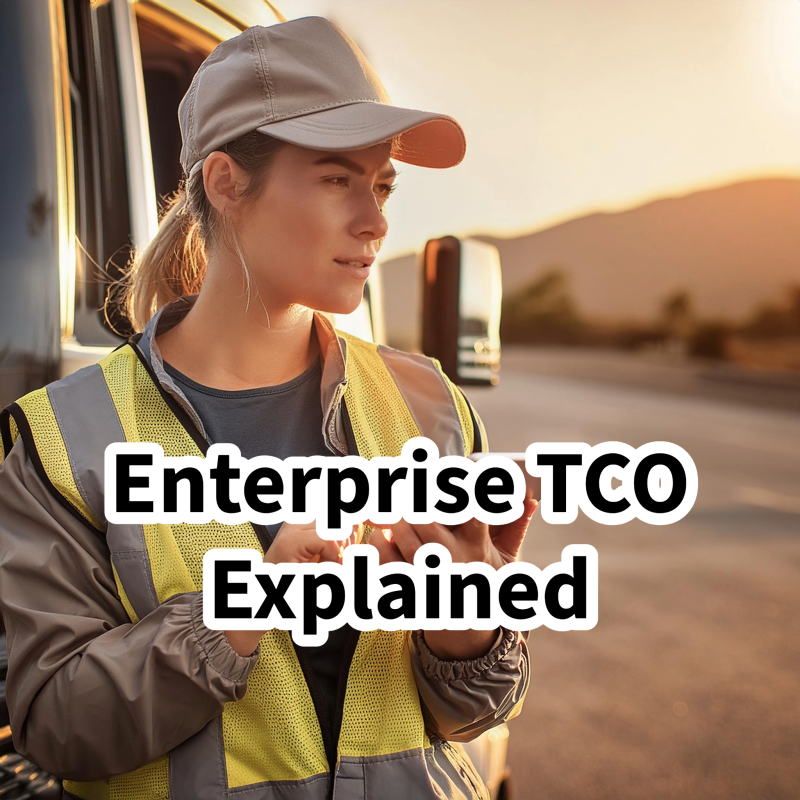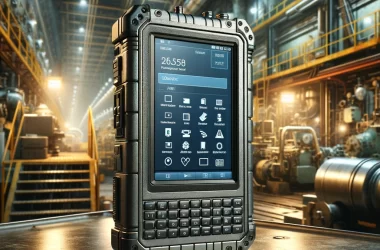In today’s increasingly digital and mobile-driven world, enterprise mobile computers have become indispensable tools for businesses of all sizes and across various industries. These powerful devices enable employees to perform critical tasks, access real-time information, and communicate instantly, thereby boosting productivity and streamlining operations. However, when considering the adoption of mobile computers, it is crucial to evaluate not just the upfront cost but also the total cost of ownership (TCO).
Understanding the Concept of Total Cost of Ownership
Definition of Total Cost of Ownership
Total Cost of Ownership (TCO) refers to the comprehensive evaluation and calculation of all expenses associated with acquiring, deploying, maintaining, and retiring enterprise mobile computers throughout their useful lifespan. TCO encompasses not only the initial purchase price but also the ongoing costs, including hardware and software upgrades, maintenance and support, training, and other related expenditures.
When calculating TCO, it is crucial to take into account not just the direct costs but also the indirect costs that may arise over time. These indirect costs can include productivity losses due to system downtime, cybersecurity breaches, and potential regulatory compliance issues. By factoring in these hidden costs, businesses can have a more accurate understanding of the true financial impact of their technology investments.
Importance of Total Cost of Ownership in Business
By considering TCO before investing in enterprise mobile computers, businesses can make more informed decisions and avoid costly surprises down the line. TCO analysis provides a holistic view of the financial implications, enabling organizations to select the most cost-effective solutions, maximize return on investment, and allocate resources efficiently.
Furthermore, a thorough TCO analysis can help businesses identify areas where cost savings can be achieved without compromising on quality or performance. This proactive approach to cost management can lead to long-term sustainability and competitiveness in the market. By understanding the full scope of expenses associated with their technology assets, businesses can develop strategic plans that align with their budgetary constraints and operational goals.
Factors Influencing the Total Cost of Ownership for Mobile Computers
Several key factors contribute to the total cost of ownership for enterprise mobile computers. Understanding these factors is essential for accurately assessing TCO and making strategic decisions.
When delving into the realm of hardware and software costs, it’s crucial to recognize that the initial purchase cost of mobile computers is just the tip of the iceberg. Beyond the shiny facade of new devices lie the expenses associated with software licenses, upgrades, and compatibility. Opting for top-notch, reliable hardware from the get-go can potentially mitigate the need for costly repairs or premature replacements, ultimately impacting the overall TCO.
Hardware and Software Costs
The initial purchase cost of mobile computers is just one aspect of the TCO equation. Businesses must also consider the expenses associated with software licenses, upgrades, and compatibility. Investing in reliable and durable hardware upfront can reduce the need for expensive repairs or premature replacement.
Moreover, maintenance and support expenses form a critical, yet often underestimated, component of TCO. These ongoing costs encompass routine maintenance, repairs, troubleshooting, and software updates. Organizations must factor in the potential repercussions on downtime and productivity when assessing the value of maintenance and support services provided by vendors.
Maintenance and Support Expenses
Maintenance and support costs are ongoing, often overlooked components of TCO. These expenses include routine maintenance, repairs, troubleshooting, and software updates. Organizations need to factor in the potential impact on downtime and productivity when evaluating maintenance and support services offered by vendors.
Additionally, the realm of training and implementation costs should not be underestimated in the TCO equation. Proper training and seamless implementation are pivotal in maximizing the efficacy of enterprise mobile computers. Whether opting for in-house training programs or outsourcing to industry professionals, financial investments are imperative. Businesses must also account for the time and resources necessary to ensure smooth implementation across their workforce, further influencing the overall TCO.
Training and Implementation Costs
Proper training and implementation play a crucial role in maximizing the effectiveness of enterprise mobile computers. Training programs, whether conducted in-house or outsourced to professionals, necessitate financial investments. Additionally, businesses need to consider the time and resources required for seamless implementation across their workforce.
Calculating the Total Cost of Ownership for Enterprise Mobile Computers
Accurately calculating TCO can be a complex process, but it is a critical step in making informed decisions. By following a systematic approach and utilizing the right tools, organizations can gain valuable insights into the true cost of adopting mobile computers.
Step-by-Step Guide to TCO Calculation
1. Identify and list all the costs associated with enterprise mobile computer adoption, including hardware, software, maintenance, support, training, implementation, and other applicable expenses.
2. Determine the useful lifespan of the mobile computers and estimate the timeframe over which the costs will be incurred.
3. Assign monetary values to each cost item based on research, vendor quotes, and historical data.
4. Sum up all the costs over the designated timeframe to obtain the TCO.
Common Mistakes in TCO Calculation
When calculating TCO, organizations should be aware of common pitfalls that can lead to inaccurate assessments. One common mistake is underestimating maintenance and support expenses. It is imperative to account for potential repairs, extended warranties, and software updates to avoid unforeseen costs later on.
Additionally, neglecting the impact of training and implementation costs can result in suboptimal usage, decreased productivity, and higher TCO in the long run. Organizations must carefully consider the investment required for comprehensive training and smooth implementation to realize the full potential of enterprise mobile computers.
The Importance of Vendor Selection
Choosing the right vendor is a crucial factor in accurately calculating the TCO for enterprise mobile computers. It is essential to thoroughly evaluate potential vendors and consider factors such as reputation, reliability, and customer support. Opting for a reputable vendor with a proven track record can minimize the risk of unexpected costs and ensure a smoother implementation process.
Moreover, organizations should consider the vendor’s long-term commitment to product development and support. Mobile technology is constantly evolving, and selecting a vendor that offers regular updates and improvements can help extend the lifespan of the mobile computers and reduce the overall TCO.
Considering Scalability and Future Needs
Another aspect to consider when calculating the TCO is scalability and future needs. Organizations should assess whether the chosen mobile computers can accommodate potential growth and changing requirements. Investing in a solution that can easily scale with the organization’s needs can help avoid costly replacements or upgrades in the future.
Furthermore, organizations should consider the potential for integration with existing systems and workflows. Seamless integration can streamline operations and reduce the need for additional customization or development, ultimately contributing to a lower TCO.
Strategies to Reduce the Total Cost of Ownership
Minimizing TCO for enterprise mobile computers involves a combination of careful decision-making and proactive measures aimed at optimizing efficiency and longevity.
Reducing the total cost of ownership (TCO) for enterprise mobile computers is a critical objective for organizations looking to maximize their investments. By implementing effective strategies and best practices, businesses can ensure that their mobile computing devices deliver long-term value and performance.
Choosing the Right Mobile Computer
Before making a purchase, thorough research and evaluation of different mobile computer options are vital. Organizations should identify their specific requirements for performance, durability, and compatibility to ensure they select devices that meet their needs, preventing costly replacements or upgrades in the future.
Factors such as battery life, processing power, ruggedness, and operating system compatibility play crucial roles in determining the suitability of a mobile computer for a particular enterprise environment. By conducting a detailed analysis of these factors and aligning them with organizational needs, businesses can make informed decisions that contribute to long-term cost savings.
Investing in Quality Hardware and Software
Though it may be tempting to opt for cheaper alternatives, investing in quality hardware and software can save money in the long run. Reliable devices and robust software typically require less maintenance, experience fewer compatibility issues, and offer better longevity, ultimately reducing TCO.
High-quality hardware components, such as durable casings, advanced processors, and high-resolution displays, contribute to the overall reliability and performance of mobile computers. Similarly, using licensed software with regular updates and support ensures optimal functionality and security, reducing the risk of system failures and data breaches that can incur significant costs.
Effective Training and Support
Thoroughly training employees on the features and capabilities of enterprise mobile computers can increase productivity and reduce user errors that may result in costly downtime or data loss. Additionally, timely and reliable support services can help address and resolve issues promptly, minimizing disruptions and mitigating long-term costs.
Employee training programs should cover not only the basic operations of mobile computers but also best practices for data security, device maintenance, and troubleshooting common issues. Access to knowledgeable technical support staff and resources ensures that any issues or concerns are addressed promptly, minimizing productivity losses and maintaining operational efficiency.
The Future of Total Cost of Ownership for Mobile Computers
As technology continues to advance at a rapid pace, the landscape of TCO for mobile computers is likely to evolve in the coming years.
Impact of Technological Advancements
Ongoing advancements in mobile computer technology, including improved durability, longer battery life, and enhanced performance, are expected to positively influence TCO. As devices become more efficient and reliable, businesses can potentially reduce maintenance and replacement costs while maximizing productivity and return on investment.
Predicted Trends in TCO for Mobile Computers
Looking ahead, several trends may shape the future of TCO for mobile computers. These include the increasing prevalence of subscription-based models, where upfront costs are minimized, but recurring fees contribute to the TCO over time. Furthermore, the integration of artificial intelligence and machine learning capabilities in mobile computers may impact maintenance, support, and training costs, potentially reducing TCO through automation and predictive analytics.
In conclusion, understanding the concept of total cost of ownership is critical for organizations considering the adoption of enterprise mobile computers. By comprehensively evaluating the factors that influence TCO, accurately calculating costs, and implementing strategies to minimize expenses, businesses can make informed decisions that maximize the benefits and minimize the total cost of ownership over the lifespan of the devices.










